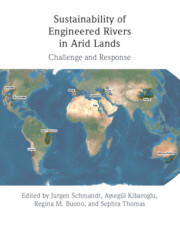Book contents
- Sustainability of Engineered Rivers in Arid Lands
- Sustainability of Engineered Rivers in Arid Lands
- Copyright page
- Dedication
- Contents
- Contributors
- Part I Introduction
- Part II Challenge
- Part III Engineered Rivers
- Part IV Response
- 16 River Basin Management and Irrigation
- 17 “Intelligent” Water Transfers
- 18 Better Basin Management with Stakeholder Participation
- Part V Conclusion
- Index
- References
17 - “Intelligent” Water Transfers
from Part IV - Response
Published online by Cambridge University Press: 16 September 2021
- Sustainability of Engineered Rivers in Arid Lands
- Sustainability of Engineered Rivers in Arid Lands
- Copyright page
- Dedication
- Contents
- Contributors
- Part I Introduction
- Part II Challenge
- Part III Engineered Rivers
- Part IV Response
- 16 River Basin Management and Irrigation
- 17 “Intelligent” Water Transfers
- 18 Better Basin Management with Stakeholder Participation
- Part V Conclusion
- Index
- References
Summary
Inter-basin water transfers (IBWT) offer an approach to addressing water scarcity by confronting the mismatch between water supply and demand in the context of a sustainable development policy. However, IBWTs are often criticized – particularly when the water transfer involves crossing political boundaries. In those circumstances, the policy debate often tends to lose sight of important aspects that guarantee a rational water policy. This chapter addresses issues related to water transfers between river basins, not only in the hydrological term but also, quite frequently, over political boundaries (transboundary water transfer). We present a number of case studies chosen to provide a representative geographical view of IBWTs around the world and insights on the different aspects that involve IBWTs. Intelligent IBWT should be implemented in the context of more general sustainable development strategies and Integrated Water Resources Management.
- Type
- Chapter
- Information
- Sustainability of Engineered Rivers In Arid LandsChallenge and Response, pp. 246 - 259Publisher: Cambridge University PressPrint publication year: 2021



